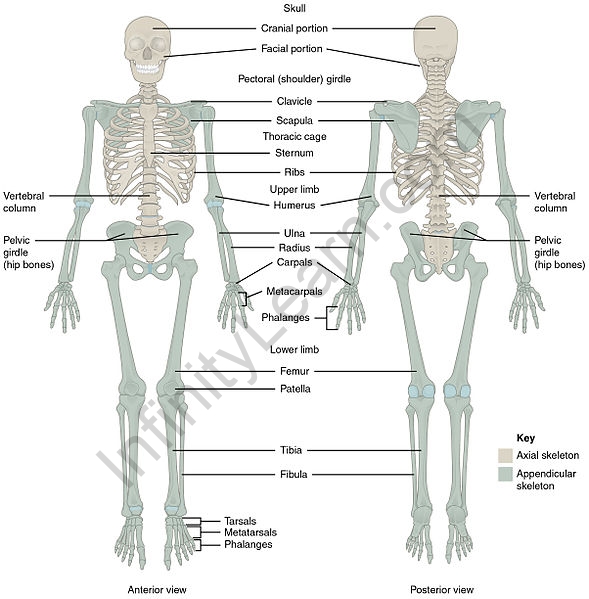Table of Contents
Introduction
The human skeletal system is the internal structure of the human body. It is made up of about 270 bones at birth – this number drops to about 206 bones as a person grows older after the other bones have been assembled. The bone mass in the skeleton makes up about 14% of total body weight and reaches maximum density within 21 years.
Definition of the Skeletal System
The human skeletal system acts as the central nervous system. It includes bones and connective tissue, including ligaments, muscles, and cartilage. Experts also call it the musculoskeletal system. This system is very important for the body and makes up about 20 percent of the average human body weight. The total number of bones in an adult skeleton is 206. The skeletal system of children contains 300 bones because of their growth process. There is also a difference between the male skeleton and the female skeleton. The skeletal structure of a man is characterized by a higher bone mass compared to females. Let’s learn more about the various features of the skeletal system.

Components of the Skeletal System
The skeletal system includes a network of multiple components that work together to facilitate physical movement. Bones make up the main part of this system and the body structure.
- Periosteum: This strong membrane protects the outside of the bone.
- Joint bone: Located below the periosteum, the joint bone provides protection and structural support to the body. It is smooth, strong, and white in color.
- Tendons: Tendons are bands of tissue that connect bones to the edges of muscles.
- Spongy bone: The inner bone of the bone, the spongy bone, is soft compared to the jointed bone. It contains small holes that hold the bone marrow.
- Joints: A joint is where two or more bones meet. There are three different types of members — immobile members, partially moving joints, and moving joints.
- Immovable joints: Do not allow any bone movement, for example, joints between skull bones.
- Partial moving limbs: They help with limited bone movement, such as the joints in your bones.
- Moving joints: facilitate bone movement, for example, the joints in the knee, shoulder, and elbow.
- Cartilage: Cartilage closes the tips of your bones and directs their movements gradually. Therefore, the bones do not rub against the cartilage. As you grow older, the cartilage may age, causing pain and movement problems. It is smooth and flexible in nature.
- Lines: Lines are strips of strong connective tissue whose function is to hold the bones together.
Skeletal System Functions
The functions of this program are as follows:
- Provides shape and structure: The skeletal structure provides shape and structure to the body.
- Provides immunity: The skeletal system provides vital protection against vital organs. For example, the heart and lungs are protected by ribs.
- Assisted movement: The skeletal system allows a person to stand up and walk. This may be due to the interaction of muscles, connective tissue, and joints.
- Blood cell production: Bones contain bone marrow that is responsible for producing white and red blood cells.
- Mineral storage: The body’s supply of minerals is contained in the bones. For example, they provide essential minerals such as calcium and vitamin D.
Conditions Affecting the Bone System:
Like any other body system, the skeletal system is immune to disease and injury. Below are some examples of skeletal system conditions:
- Arthritis: Joints disappear from arthritis and are characterized by pain in those areas. Its causes are joint rot, injury, aging, muscle weakness, autoimmune disorders, and genetic history.
- Fracture: When severe stress is placed on it, the bone may break. Fractures are a very common occurrence in aging as bones become weaker and weaker.
- Osteosarcoma: Osteosarcoma is the most common type of cancer in the bones. New bone growth cells from cancerous growths. If the condition persists, the tumors may cause bone fractures.
- Sprains and Tears: Connected tissues are damaged or degenerated over time such as sprains or tears.
- Osteoporosis: A certain amount of bone loss is common with age. However, osteoporosis is a condition characterized by severe bone loss. The bones become brittle and have large holes in them. The reason for this is a lack of calcium in the body.
Also read: Important Topic Of Biology: Skeletal Muscle
FAQs
What are Tendons, Ligaments, and Cartilages?
Tenders are part of connective tissue that connects bone tissue to bones. The ligaments are bands of connective tissue that connect bones to other bones to form joints and cartilage is the soft, flexible, and strong tissue that binds and protects the bones in the joints. It is present in the ribs, ears, nose, intervertebral discs, and bronchial tubes, to name a few.
What diseases are related to the Skeleton System?
Various diseases linked to the human skeletal system are osteoporosis, pager disease, and rheumatoid arthritis. Osteoporosis is a bone-related disease in which the bone density is low and increases the risk of fractures. Paget's disease is a chronic orthopedic disease that causes the affected bones to become weak and brittle. Arthritis is a joint inflammation when difficulty and pain of movement occur.








